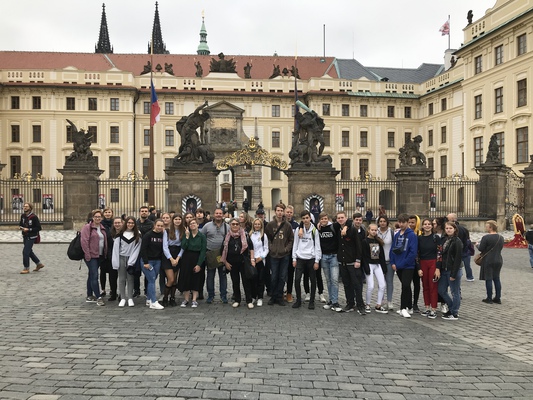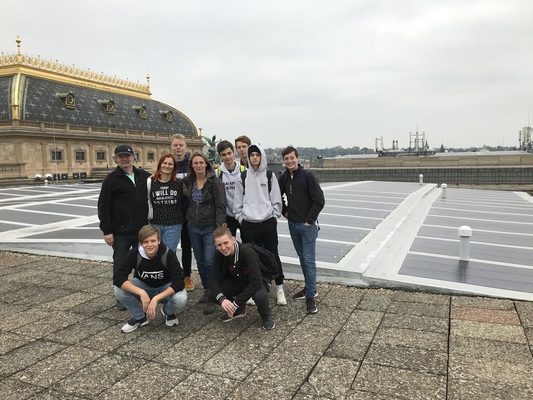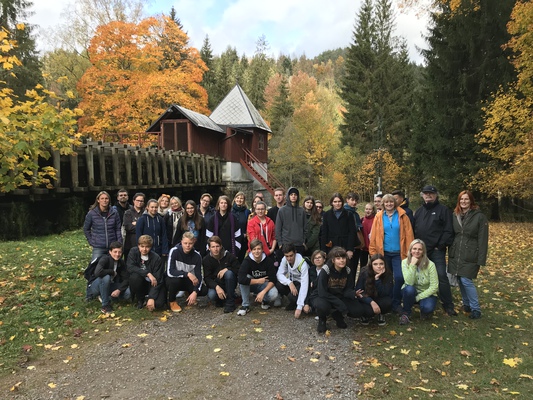Erasmus+ KA229 - School Exchange Partnerships
Project Nr: 2019-1-CZ01-KA229-061106 _1 It´s our world - take care of it
Event host organization: Střední odborné učiliště elektrotechnické, Plzeň, the Czech Republic
Report of the learning activity C1
SDG - Affordable and Clean Energy
in the Czech Republic
The program was prepared to fulfil the main goals of Learning Activity (LA) Clean Energy: to understand the ways of producing energy; to realise the importance of using affordable alternative sources of energy and to learn how to save the energy.
Pilsner newsletter.docx
1st day October 13, 2019
All groups (Poland, Spain, Italy) arrived. Spanish students were accommodated in Czech families and the others at the school hostel. Students from Italy could not come, they will take part in other learning activities.
2nd day October 14, 2019
The groups were officially welcomed and greeted by the headmaster of the school Mr. Jaroslav Černý at SOUE. We introduced SDG goals and the main goal of this LA.
For the beginning we prepared ice-break activity for students to get to know each other better and to improve future communication among all participants. After that Czech students presented a short presentation about the school SOUE. SOUE (high and vocational school of electrical engineering) is a technical school for students between 15 – 19 years old – about 700 daily students and about 200 distance ones – adults. Branches of study except electrical engineering are also telecommunication and information technology. Students have theoretical lessons at school and practical lessons at school special labs or companies. The school operates the hostel and the canteen.
The main part of the morning program was an interactive lecturer of the representative of the company CEZ. CEZ Group is an established, integrated electricity conglomerate with operations in a number of countries in Central and South-eastern Europe and Turkey, headquartered in the Czech Republic. During the lecture participants were informed about: sources of energy used not only in the CR but in the whole Europe; alternative sources of energy – how they work, their advantages and disadvantages; ways of saving energy. During the lecture students asked many questions and got lots of new information.
The second part of the morning activity were the presentations done by students and teachers from all countries about sources of energy used in each country and region; alternative sources of energy in each country and region; nuclear energy.
The lunch was served in the school dining hall. After lunch we divided students into six language mixed groups (they worked in the same group during the whole week). The first task for the groups was to prepare a dictionary of a special terminology from the topic energy in several languages – Czech, Polish, Spanish, Italian and English. The main aim of this workshop was introducing team work, improving English and ICT skills. Teachers took part the role as the mentors of each group and tried to encourage students during their work and helped where it was needed. Sometimes we learnt new knowledge from each other.
After the afternoon workshop all groups went to the city Pilsen where the students participated in international team activity (town quiz rally) – using the map of historical centre - to be familiarised with Pilsen, its sights and history. Their task was to answer several questions which included visiting historical buildings, drawing and writing important facts about them, making interview with foreign tourists, drawing old houses or sculptures and also taking pictures of themselves on interesting spots. During the town quiz rally students used not only their knowledge of history and geography but also cooperation, teamwork and language skills.
Pilsen – historical city, was founded in 13th century on the confluence of 4 rivers with many sights – gothic cathedral, renaissance city hall, Jewish synagogue. Nowadays it is a modern city with strong industry. Plzeň, which is also called Pilsen in English and German, is a city in western Bohemia in the Czech Republic about 90 kilometres west of Prague, it is the fourth most populous city in the Czech Republic with 170 000 inhabitants. The city is known worldwide for Pilsner beer. There are many schools – primary, secondary and West Bohemia University.
This day was finished with a project meeting of all teachers where there were discussed the important project issues, outputs, project timetable and the next LA in Poland.
3rd day October 15, 2019
After breakfast we went for a day trip to Prague.
Prague is the capital and largest city of the Czech Republic. It is the 14th largest city in the European Union. It is also the historical capital of Bohemia. Situated in the north-west of the country on the Vltava River, the city is home to about 1.4 million people. Founded during the RomaHYPERLINK "https://en.wikipedia.org/wiki/Romanesque_architecture"nesque and flourishing by the Gothic, Renaissance and Baroque eras, Prague was the capital of the kingdom of Bohemia and the main residence of several HolyHYPERLINK "https://en.wikipedia.org/wiki/Holy_Roman_Emperor" Roman Emperors, most notably of Charles IV (r. 1346–1378). It was an important city to the Habsburg Monarchy and its Austro-Hungarian Empire. The city played major roles in the Bohemian and Protestant Reformation, the Thirty Years' War, and in 20th-century history as the capital of Czechoslovakia, during both World Wars and the post-war Communist era. Prague is home to a number of famous cultural attractions, many of which survived the violence and destruction of 20th-century Europe. Main attractions include the Prague Castle, the Charles Bridge, Old Town SquaHYPERLINK "https://en.wikipedia.org/wiki/Old_Town_Square_(Prague)"re with the Prague astronomical clock, the Jewish Quarter etc. Since 1992, the extensive historic centre of Prague has been included in the UNESCO list of World Heritage Sites.
We arrived in Prague at 10 a.m. to start our sightseeing tour. During the sightseeing we were guided by the professional guide who could speak not only English but also Spanish. She showed us the historical parts of the city such as Prague Castle, Nerudova Street, Kampa, Charles Bridge, Klementinum and Staromestske Square. She talked about the history of the city and the CR in a very interesting and friendly way.

After a short break we came to the building of National Theatre where we were offered to see the solar panels which are installed on the top of the roof. We had to use the lift, several stairs and finally climb the ladder to get on the top of the roof. It was a bit adventurous.

Those panels are the part of a small solar power plant which supplies some energy for National Theatre. The building of solar panels was a part of the whole project which saves the theatre a lot of money every year. Installing solar panels, replacing incandescent bulbs with LED lights, using heat from stage hydraulics, and other measures saved the National Theater over CZK 93 million in ten years. A photovoltaic power plant, which is part of the roof waterproofing and is visible only from above, does not interfere with the architecture of the surroundings on the roof of the operational building and the New Stage. The panels on the operating building together with the photovoltaic power plant on the roof of the New Stage cover a sixth of the minimum theater consumption, which in extreme cases is up to 6 MW. Participants could see original project in the middle of a big city; this project belongs definitely to those which we can call clean – green – energy.
After that students and teachers had some free time to buy some food or souvenirs.
At 6 p.m. we met again (nobody got lost luckily), walked to our bus and went back to Pilsen.
4th day October 16, 2019
After breakfast in the school dining hall all participants of the project went f by coach or a day trip to the Šumava Mountains. The destination was Čeňkova Pila, where we visited the water power plant Vydra with a guide from company CEZ.
The small hydropower plant Vydra is situated near the confluence of the Vydra and Kremelna rivers between the villages Rejstejn and Srni in the Susice district. The power plant construction started in 1937. In 1939 it started to operate as a run-of-river power plant and the full operation started only after the storage reservoir was finished in January 1942. Water is conveyed from the historical Vchynicko-Tetov canal near Mechov. During the years 2005 and 2006, both turbines were modernized.
We saw the exposition of CEZ „ The Šumava Energy “, which contains a landscape model of the area from Modrava to the confluence of Vydra and Křemelná rivers, historical instruments and model of hydro power plant with an active simulation of technological process. We could see some of the thematically related films and very interesting was the visiting of the nearby small hydro power plant Čeňkova Pila from 1912. Participants could see the second alternative source of energy – one of the most historically used – water power plant. Now they can understand the importance and possibilities of clean energy.

Then we went to Sušice, which is called the gateway to the Šumava mountains. We had some free time to have lunch and to buy some souvenirs. We could see the historical square with the Town Hall in the middle.
Our next stop was Velhartice Castle, which belongs to Unesco heritage. A very characteristic feature of Velhartice Castle is the stone bridge connecting the representative palace section with the defensive tower in the north-eastern part of the castle. The guided tour of the castle was very interesting for all of us and we enjoyed the amazing view of the surrounding area.
Then we went back to Pilsen, where we had dinner in the school dining hall.
Some of us enjoyed the evening bowling.
5th day October 17, 2019
After breakfast we all met at school. Students were working in their groups on their presentations. The topic was “What you have experienced during the week in the CR” All teams could use their notebooks, posters, markers, phones..... and also the help of all teachers. Students got again the opportunity to improve their English, ICT skills, creativity and cooperation.
Then we went to the city centre and had some free time there.
At 13:00 there was an official meeting at Region Council with local representatives. During this meeting we introduced program Erasmus+, our project and pointed out that the project is financed by the European Union. We also saw the film and presentation in English about the region and the Czech educational system.
In the afternoon we walked to the technical museum called Techmania centre. Techmania is based on explanations of particular physical or mathematical principles by means of game-like activities. The interactivity involves visitors making the exhibits move, so the natural principle will be demonstrated by the particular process. In these cases, learning is based on personal experience. All students and also the teachers enjoyed the time in Techmania. In the end we visited Planetarium where we watched 3D movie about history of flying.
At 6 p.m. we had dinner in your school dining hall. After that there was a farewell party at school for teachers, students, parents and our guests – representatives from the School Department of Pilsen Region and a representative of the company CEZ.
At the beginning all groups had a chance to show their presentations which were really interesting, imaginative and also amusing. Then our guests were welcomed. Ms. Jaroslava Havlíčková and Mr. Ladislav Harvanek - representatives from Region Council - talked about the importance of international projects and thanked us for our project week. The representative of the company CEZ admired the whole project and the topic clean energy. The party continued with music and dancing.
During the meeting we introduced – disseminated – the project and Erasmus program to the wide public.
6th day October 18, 2019
After breakfast students met at school and they were divided into their teams for the following workshop. They worked on different tasks connected with the topic of Affordable and clean energy. The last part of their workshop was to draw a dream island involving the questions of getting food, living, transport and producing and saving energy. All teams then presented their posters. All works and presentations were interesting. We could see how students incorporated new knowledge from this LA. During the workshop we also talked about saving energy in our everyday lives at home, at school, at work etc. It was also interesting to see the teamwork and cooperation of students. We could really see how the participants were integrated in one cooperating international group.
After a short break we evaluated the whole learning activity. We prepared the evaluation questionnaire and all participants filled it. Then we used the results for evaluation of this learning activity.
Before lunch there was a short tour around our school. The teachers discussed the plans for the next learning activities, local activities and project dissemination.
Our project week was officially concluded. We could say that this LA fulfilled the main project aims.
7th day October 19, 2019
We said goodbye to each other and all groups returned to their home countries.
"The European Commission support for the production of this publication does not constitute an endorsement of the contents which reflects the views only of the authors, and the Commission cannot be held responsible for any use which may be made of the information contained therein."